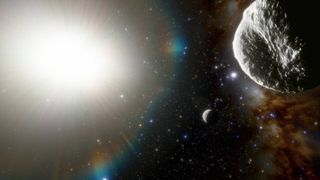Astronomers discover the Usain Bolt of asteroids blazing around Sun
Only Mercury has a quicker orbit in the solar system

Astronomers just discovered the fastest-known asteroid in the solar system, which tore through its latest long, elliptical lap around the sun in just 113 days, getting so close to the star on its nearest approach that its surface was hot enough to melt lead.
The space rock, designated 2021 PH27, has the shortest orbital period of any known object in the solar system other than Mercury – which has an orbital period of a mere 88 days – but 2021 PH27 does have a longer elliptical orbit that crosses both Mercury's and that of Venus.
On its closest approach, 2021 PH27 gets to within about 12.4 million miles, or 20 million km, from the sun, which is more than twice as close as Mercury gets on its closest approach, about 29 million miles, or 47 million km. When it does, the surface of 2021 PH27 rises to about 900 degrees Fahrenheit, or about 500 degrees Celsius.
Discovered on August 13 by the Carnegie Institution of Science's Scott S. Sheppard, using the Dark Energy Camera atop the Víctor M. Blanco 4m Telescope at Cerro Tololo Inter-American Observatory in Chile, an international team of astronomers across two continents and Hawaii worked together to observe the asteroid over the next few days to confirm the speed and orbit of 2021 PH27 – even though it meant delaying their own projects for which they had reserved valuable telescope time.
"Though telescope time for astronomers is very precious," Sheppard said in a statement, "the international nature and love of the unknown make astronomers very willing to override their own science and observations to follow up new, interesting discoveries like this."
The asteroid is entering what's called solar conjunction, which is a fancy way of saying that it appears to us on Earth like it is moving 'behind' it, and is expected to reemerge on the otherwise sometime next year. At that point, scientists hope to more precisely determine its orbit, after which the asteroid will get its official name.
Analysis: 'interior' asteroids like 2021 PH27 helps us understand threats to Earth from 'exterior' ones
Most asteroids in the solar system reside in the major asteroid belt between Mars and Jupiter and so they are of particular interest to us Earth folk, since that's where the danger to our planet is going to come from.
Get daily insight, inspiration and deals in your inbox
Get the hottest deals available in your inbox plus news, reviews, opinion, analysis and more from the TechRadar team.
Asteroids in this part of the solar system can get dislodged from their trajectories for any number of reasons, but gravitational perturbations from Jupiter are the most common way that these space rocks get flicked in towards the inner planets. Those asteroids orbiting the sun inside of Earth's orbit, then, are most likely those that got sent into the inner solar system but missed hitting us or one of the other three terrestrial planets.
"The fraction of asteroids interior to Earth and Venus compared to exterior will give us insights into the strength and make-up of these objects," Sheppard explained.
"Understanding the population of asteroids interior to Earth’s orbit is important to complete the census of asteroids near Earth, including some of the most likely Earth impactors that may approach Earth during daylight and that cannot easily be discovered in most surveys that are observing at night, away from the Sun," he added.

John (He/Him) is the Components Editor here at TechRadar and he is also a programmer, gamer, activist, and Brooklyn College alum currently living in Brooklyn, NY.
Named by the CTA as a CES 2020 Media Trailblazer for his science and technology reporting, John specializes in all areas of computer science, including industry news, hardware reviews, PC gaming, as well as general science writing and the social impact of the tech industry.
You can find him online on Threads @johnloeffler.
Currently playing: Baldur's Gate 3 (just like everyone else).
